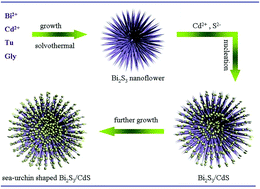One-pot controlled synthesis of sea-urchin shaped Bi2S3/CdS hierarchical heterostructures with excellent visible light photocatalytic activity†
Abstract
In this study, sea-urchin shaped Bi2S3/CdS hierarchical heterostructures are successfully synthesized via a convenient one-pot growth rate controlled route. The product is mainly composed of Bi2S3 nanorods and CdS nanoparticles grown on their surfaces. The formation mechanism was proposed based on the evolution of morphology as a function of solvothermal time, which involves fast formation of the initial sea-urchin shaped Bi2S3 nanoflowers, followed by the gradual growth of numerous CdS nanoparticles on Bi2S3 nanoflowers. The effects of CdS in the composites on their microstructures, optical absorption properties, and photocatalytic activity were investigated comparatively. Due to the synergetic effects between hierarchical Bi2S3 nanoflowers and CdS nanoparticles, the obtained Bi2S3/CdS hierarchical heterostructures exhibit superior catalytic activity over the independent components. Furthermore, the obtained Bi2S3/CdS hierarchical heterostructure composite shows a strong structure-induced enhancement of the photocatalytic performance for the photodegradation of rhodamine B.


 Please wait while we load your content...
Please wait while we load your content...